In 1896, the new Hungarian royal court train of Emperor and King Franz Joseph was completed, equipped with all the luxuries of the day. The royal court carriages, which were still in excellent condition at the end of the Great War, were absconded with for further use by the Romanian King Ferdinand and his wife. It is likely that when the Romanian queen, Mary, traveled to Paris shortly afterward in order to win over the participants of the peace conference, she rode in this train. The text accompanying the following pictorial account was borrowed from the descriptions published in the May 24 and June 14, 1896 issues of the Railway and Transport Gazette (Vasúti és Közlekedési Közlöny).
“The King’s new royal court train, which His Majesty has just used for the first time in making the journey from Budapest to Vienna, surpasses anything yet built in this field in terms of royal comfort and aesthetic accoutrements. The train comprises five carriages: one carriage each for Their Majesties the King and Queen, two carriages for their entourage, and a dining car. The two carriages intended for the kitchen galley were retained from the older court train, having now been furnished with electric lighting and signalling devices.
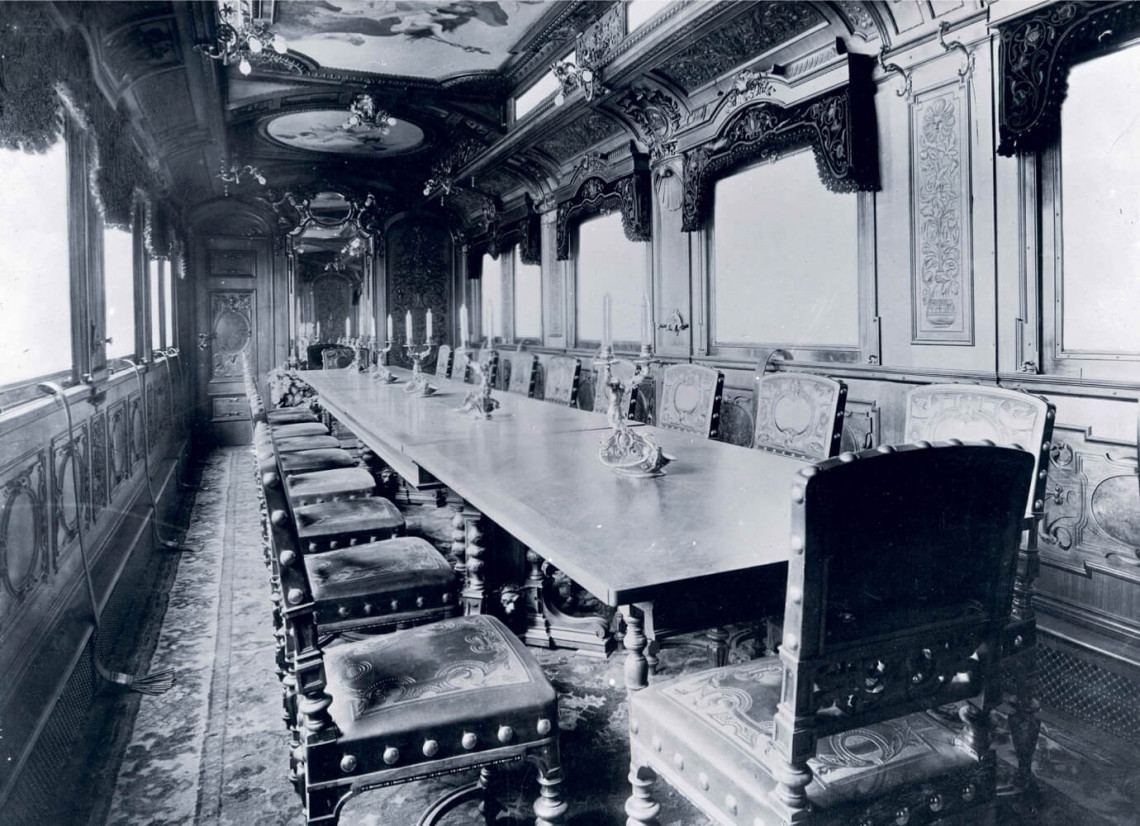
Dining car of the Hungarian royal court train
The carriages’ exteriors have maintained our customary green color except that the dark green base is now divided into panels by light green decorative stripes edged with gold. The entire exterior of the train is as unassuming as it is elegant. His Majesty’s carriage alone is distinguished by its greater splendour as a section below the salon windows is adorned with the great Hungarian coat of arms in colorful relief – made of fire-gilded bronze and cloisonné enamel – with His Majesty’s red and white dynastic coat of arms on the central shield (a crowned rampant lion and three silver eaglets). The entire coat of arms is surmounted by two angels holding the Royal Crown of Hungary aloft between them. The three central windows of the carriage are framed with a garland of rich golden bronze while the panels beneath the two flanking windows are emblazoned with His Majesty’s initials wreathed in laurel. But these unique and resplendent trimmings are only intended for ceremonial occasions and are replaced by simpler ornamentation during His Majesty’s regular journeys.
We begin our tour of the train with His Majesty’s carriage. It is seventeen and a half meters long and is mounted on six axles while the other carriages run on only four. The carriage weighs forty-one and a half tons and is naturally equipped with all the latest technology to ensure a quiet ride without any vibrations. The carriage’s interior is furnished in such a way that the designers’ imagination was only limited by the space.
First of all, we enter an octagonal foyer which impresses mainly due to its strict contours, whose severity is softened only by two mirrors. Oak and leather panelling adorns the walls and ceilings while a green carpet covers the floor. A magnificent woodcarving of the already described Hungarian coat of arms is affixed above the door leading into the carriage interior – and surmounting it are the same two angels holding the Royal Crown.
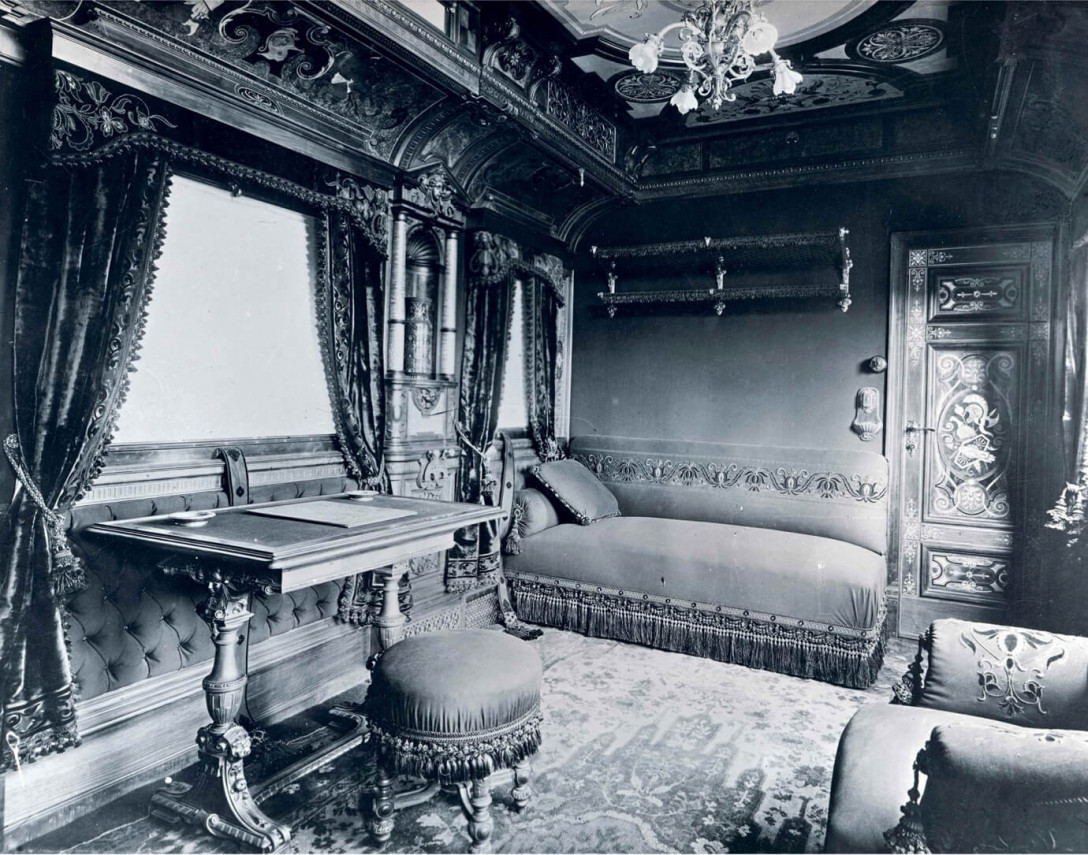
The King’s salon
Emerging from the foyer we encounter the chief adjutant’s superbly furnished suite. The furniture is made of green baize cloth, with the walls covered by the same, while the ceiling is sheathed with a richly embroidered, light-colored silk. The walls and doors are decorated with inlaid woodwork, with curtains separating the dressing room from the sleeping compartment. The writing desk is equipped with magnificent bronze mounts while the curtains and pleats are of a dark green plush; the furnishings, both in their detail and when taken as a whole, convey the impression of restrained luxury.
From here we enter His Majesty’s salon. The furniture here is made of the same dark green baize with plush edging and decorated handstitched embroidery, while the curtains are of the heaviest dark green silk plush with woven edging and lavish embroidery. Rich embroidery also adorns the central panel of the ceiling with the two outer panels displaying the most diverse and beautiful work. Here, as with all the embroidery in the King’s suite, Hungarian motifs predominate. The side walls of the carriage, inlaid with walnut, have two niche-like recesses harboring Hungarian majolica lamps. The desk pad of the King’s writing desk is monogrammed with His Majesty’s initials and the writing instruments – as with the electric lamps and the ventilation grills – are of heavy golden bronze. Most astonishing, however, is the inlaid woodwork on the doors, walls, and cornices which display not only the most valuable sorts of wood – ash, walnut, maple, cypress, ebony, pear, boxwood, and oak – but also gold, silver, ivory, tortoiseshell, and mother of pearl. The composition of this work depicts triumphal insignia, clearly patterned after models from renowned weapon collections. The longer we stay in this salon, the greater the details that come to our attention. The multitude of artistic works that fill this space would be almost overwhelming were it not for the artist’s refined vision, which allows us to overlook the mass of details by subtly merging them into a harmonious whole.
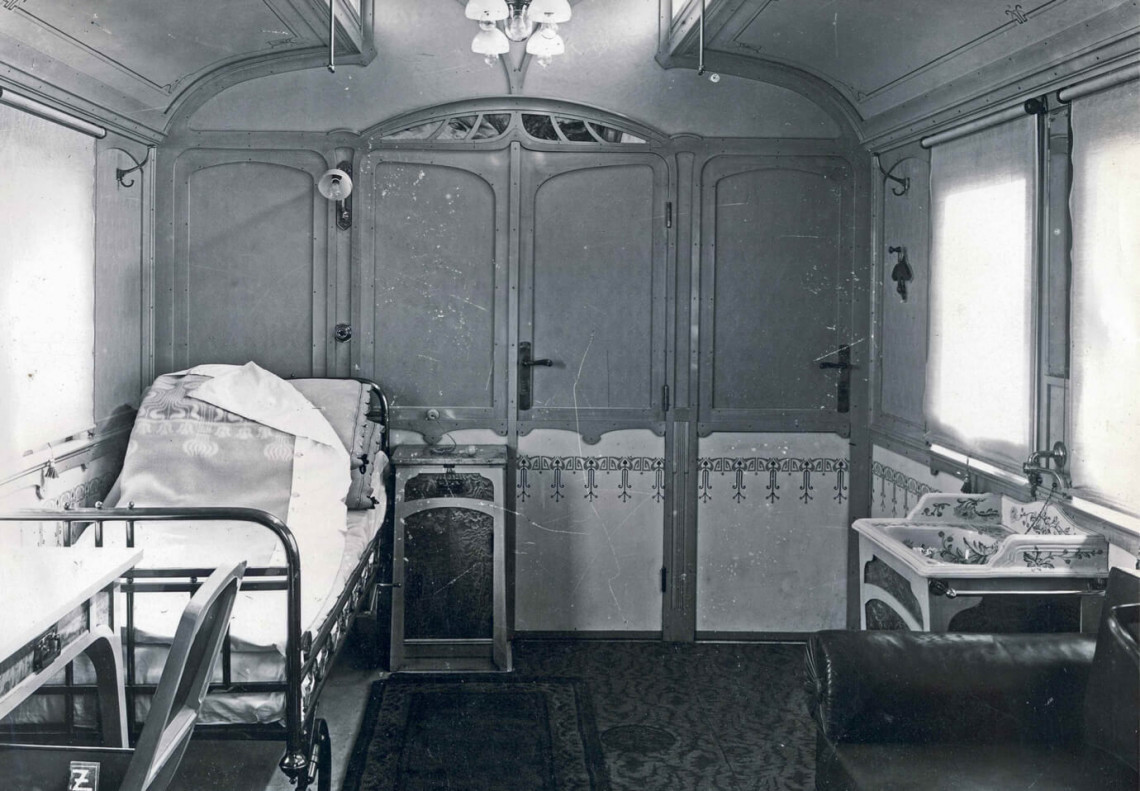
The King’s modest sleeping compartment
The nearest room is the King’s bedroom. His Majesty’s iron soldier’s bed is of course present, but it is covered with a gorgeously embroidered green silk quilt. The ceiling here also displays the richest gold embroidery, alternating between stitching and appliqué, and everywhere we encounter motifs from Hungarian folk art. The four windows of the bedroom have padded blinds that can be raised or lowered so that no noise can penetrate from the outside world at night. Next door, a separate compartment is reserved for the King’s huntsman, who can continuously monitor on a signalling device any major changes in the temperature of each carriage compartment. When temperatures exceed 18 degrees or fall below 14 degrees, the numbers indicating the temperature pop up and the huntsman can thus regulate the temperature accordingly.
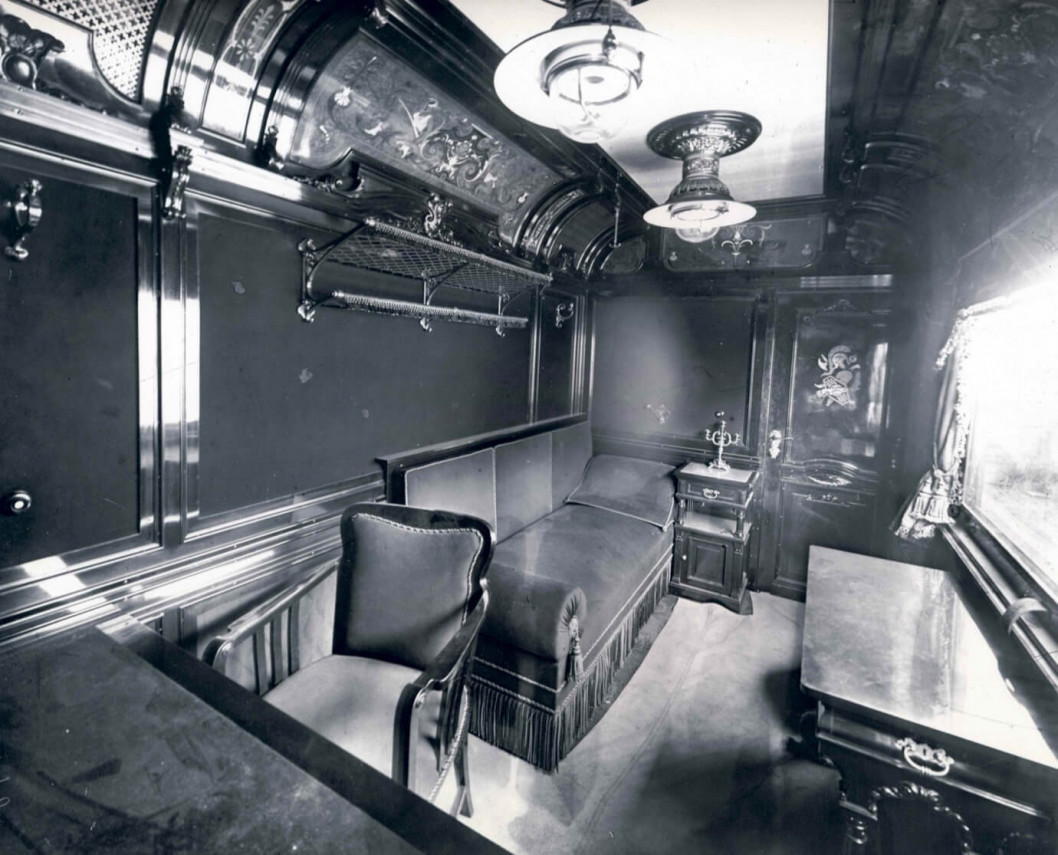
The escort’s salon
The King’s dining car, which is mounted on four axles and weighs thirty-six tons, comprises two rooms, one of which – the dining room – is about nine meters long, while the other – the smoking room – is about eight meters in length. The ceiling in the dining room is decorated with three of the last works of Károly Lotz – paintings whose vibrant colors invite the beholder to revel in their radiant joie-de-vivre. A still life by the same master is mounted in a carved frame above the entrance with two charming cherubs on either side illuminating the lovely picture with incandescent lamps inserted into horns of plenty. What draws the greatest attention in this room, however, are the three carved leather panels on the front and rear side walls which display vibrant patterns whose artistic designs are truly impressive. On the upper walls, mirrored windows alternate with carved-leather pillars while stylized fruit patterns alternate with shields below; even the interior and concave ledges are decorated with carved leather.
The ventilator grill and all metal parts are beautiful products of blacksmithing and all are made of excellent golden bronze. Twenty-six electric lamps set in twelve chandeliers illuminate the room while 20 chairs – again with carved leather – are placed along both sides of the table. On the right, in the middle, we see a chair decorated with the king’s initials and his family’s coat of arms – this is the King’s chair. The curtains covering the twelve windows are made of brown plush and are richly decorated with Hungarian motifs. A mirror rises at knee-height from of a colourful flowerbed and reaches the ceiling.
In the smoking room, the first object that catches our eye is an imposing cabinet in which jewelry is kept. The walls of the compartment are furnished from exquisitely finished walnut and the ceiling is divided into six oval panels separated by beams, each panel comprised of cream-colored silk embossed with delicate embroidery – stitched and applique – of every color. The concave cornices here also reveal carved-leather ornamentation and the entire ensemble makes an unforgettable impression.
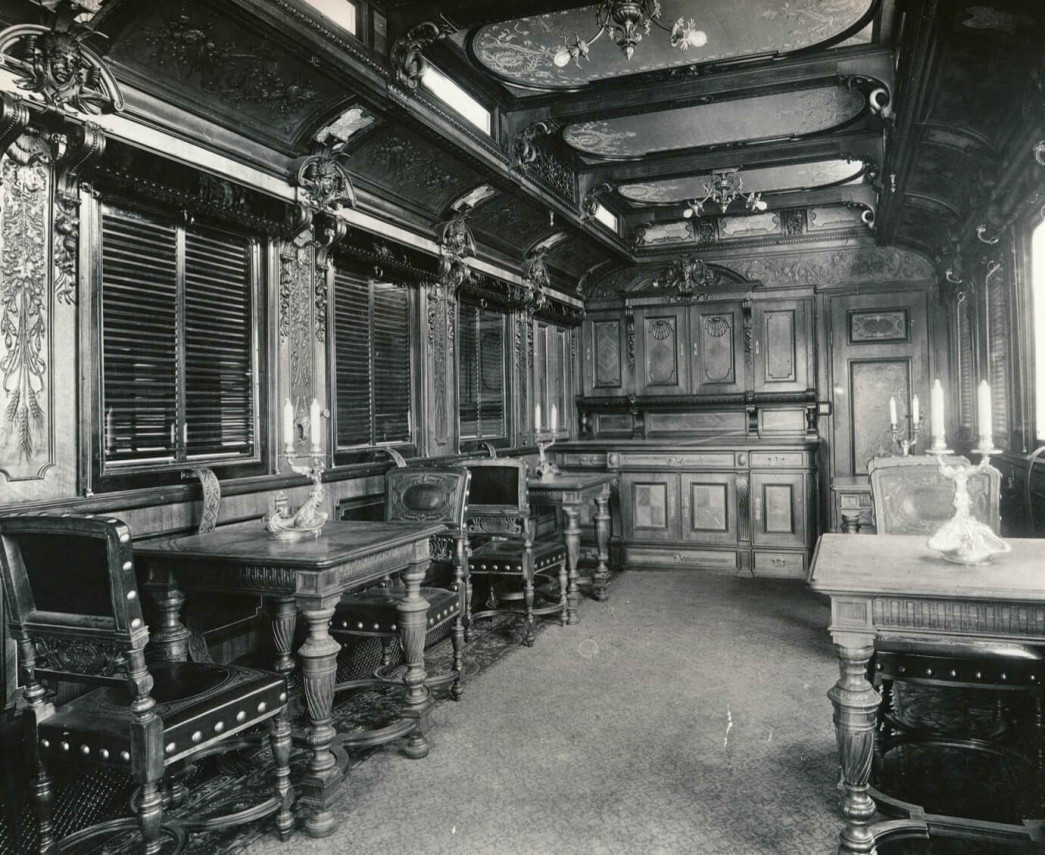
The smoking room
Two carriages are intended for the royal entourage – the first, designated A, is more upscale and more lavishly endowed in terms of space, while the second, with the appellation B, is somewhat more confined yet is still more upscale than any luxury carriage accessible to the public. Carriage A, a six-windowed lounge car, has four compartments on one side and two on the other; carriage B, with four windows, has four compartments on each side. The compartments in carriage A are for one person each, and for two in carriage B; and while the salon in carriage A is furnished with tapestry, the salon in carriage B is bedecked with red carpet. The walls of both are covered in silk faille above and walnut below. The cornices, window frames, and door panels are all richly arrayed with inlaid woodwork.
The corridors are lined with walnut and leather in the English style while the ceiling is decorated with silk embroidery in Hungarian motifs. Here too all the metal finishings are made of fire-gilded bronze and here too there is electric lighting, electric signalling and calling devices, silver washbasins, and separate water pipes and toiletry accoutrements. It is certainly quite nice and comfortable to travel in the company of Their Majesties! The entire train is powered by batteries designed to operate for forty hours. Double-windows with shutters are everywhere; in short, there are countless amenities intended to provide the utmost comfort for the journey and make the weariness as bearable as possible.
While His Majesty the King’s two carriages are reminiscent of the high point of the Italian Renaissance, the Queen’s carriage reflects French masterworks from the era of Louis XVI. Mahogany, rosewood, bronze, silk brocade, and velvet are the materials from which the traveling queen’s home was constructed.

The Queen’s luxurious bedroom
First we enter the Queen’s salon whose steel-blue curtains and exquisite variegated carpeting create a tranquil atmosphere. The side walls and ceiling, enwrapped in blue silk, are richly embroidered in the style of the period with which the entire work is imbued. The seating furniture is upholstered in copper-brown silk and edged with plush of the same color; all surfaces, including the walls, cornices, and ceiling, are richly adorned with elevated taste.
The bedroom which follows is a dazzling beauty. A canopy bed reaches the coved ceiling, its cream-colored drapery standing out beautifully against the blue faille furniture. Next, there is a magnificent mahogany writing desk with stylish finishings, graced with the Queen’s initials. The entire desk is inlaid with velvety smooth orange wood on the inside and is surmounted by a Venetian mirror which captures the reflection of the canopy bed upon which a real Japanese silk blanket is arrayed. The bed itself consists of several mattresses, the lowest of which rests on the floor, while the sovereign herself reclines on the uppermost, so that the shaking of the carriage is not felt at all or only to the bare minimum.
The furniture adorning the Queen’s dressing room is of yellow silk brocade, which makes for a splendid impression when set against the room’s silk tapestries and embroidered silk ceiling. The Queen’s washbasin is of beaten silver, as is the King’s, except that here all the accessories are made of Mexican onyx whereas in the King’s rooms – both his sleeping compartment and his salon – they are made of Hungarian marble. A floor-to-ceiling mirror provides the final touch to the exquisite furnishing.
Next to the dressing room are two compartments set aside for the Queen’s ladies-in-waiting. The furniture of these compartments is of Genoese velvet and the walls are covered with a silk frieze embroidered with flowers. The last compartment belongs to Her Majesty the Queen’s pâtissier, who, like the King’s huntsman, has a refrigerator and water supply – except that the Queen’s pâtissier also has a gas stove on which meat dishes can be prepared.
The entire court train – both in its entirety and in its various details – was constructed by the Ganz wagon factory and is a masterpiece of Hungarian industry. The interiors were designed by Professor Jiri Stibral, a well-known specialist in this field. The artistic woodwork for two of the carriage interiors was furnished by the master craftsman Endre Thék, while the magnificent fabrics and carpets made for each compartment were provided by the Fülöp Haas & Sons Company. The mechanical equipment was constructed according to the plans compiled by the mechanical engineering department of the Hungarian state railways, under the professional direction of lead engineer Kajetán Banovits with assistance of the engineers Ödön Kelényi and Winkler.”
(translated by Andrea Thürmer and John Puckett)
